Being immersed in the fitness industry provides me with a ton of different opportunities to experience different techniques, methodologies, and products. I recently had the privilege of a...


Being immersed in the fitness industry provides me with a ton of different opportunities to experience different techniques, methodologies, and products. I recently had the privilege of a...
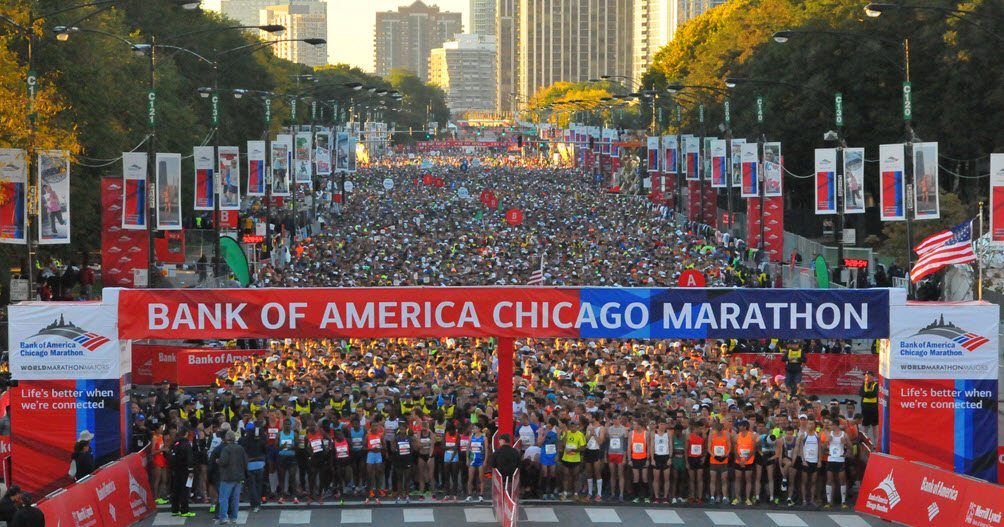
Leading up to the Chicago Marathon 2016 The Chicago Marathon provides an excellent course, plenty of support and, for me, a chance to visit home for a few days. It was no different for me this...

September 25 was going to be my day. The Ironman Augusta 70.3 triathlon was finally here. The race I had been training so hard for on one of my favorite courses. It was four-and-a-half months...
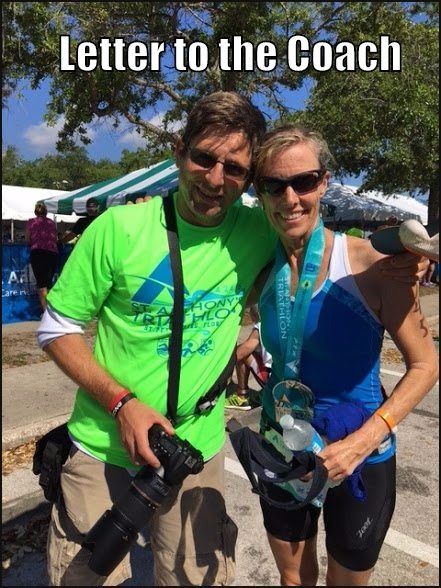
I have been an endurance coach for some time now. Once in a while, I receive an email from a client which chokes me up with pride. Today, I received one of those letters, so instead of sharing it...
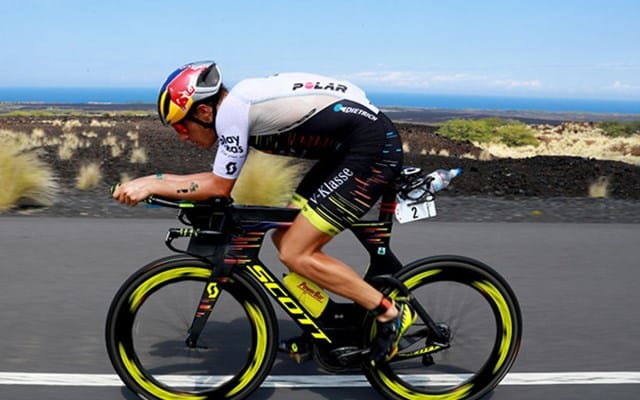
I found when looking for ways to get faster on the bike, is that there is so much information, from different coaches and experts, that it can be confusing and overwhelming. Personally, I...
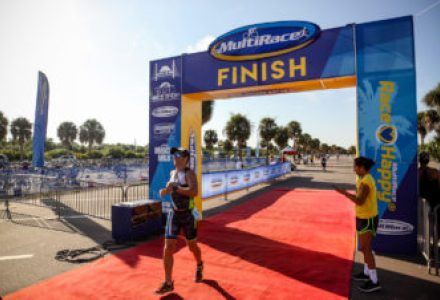
The previous post was a review of the FD3 Triathlon Series as if it was a product. Below you will find a more detailed account of my personal experiences during the race. Let me know in the...
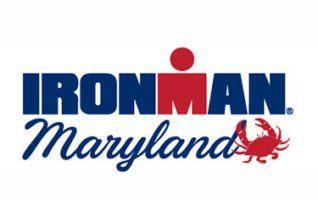
I signed up for Ironman Maryland initially due to the reviews that said it was fast, and beautiful. Jaime started it with all the hype about it being a fast flat bike course because she despises hills, even though most of her fastest bike splits came on hilly courses. Touché. So, last year after a lot of pestering Pete, we registered and the training began. Pete, Jaime and I have been training together for about 4 years, ever since I decided to get serious about triathlon. We ingeniously started calling ourselves “PB&J”. Get it? Peanut Butter and Jelly or Pete, Brad & Jaime.
Interesting enough though, I really wanted a sub 12-hour Ironman and Jaime was shooting for a sub-13, so as much as we enjoy training together we actually ended up going our own ways. I started training at Tribal Multisport with Coach Jon Noland, and Jaime trained with Personal trainer and elite athlete Kenneth Jones.
We made all the arrangements well in advance. We had hotel reservations at the host hotel, restaurant reservations, tri-bike transport was scheduled, flights were booked and cars were rented well in advance.
We talked constantly throughout the months, confirming our plans, comparing training schedules and every once in a while, we actually did get together to train. PB&J looked strong and ready to face IRONMAN Maryland together. Unfortunately, in September, Pete ended up injuring his Achilles’ tendon and after a lot of conjecture decided it wasn’t in the cards for him this year. I told him, it would better to live and race another day than to permanently hurt himself.
We departed for the race on Wednesday, September 30 completely anxious and excited. We headed to Tampa International Airport, for an uneventful flight into Baltimore-Washington Airport. Within a half hour we were in our Jeep Compass rental and headed up Rte 50 in Maryland.
We stopped for a quick lunch at Carmine’s Pizza to carb load with pizza and salad and just as we are about to pull out of our parking space and back into traffic, Jamie’s phone rings. Ed, a friend and first time Ironman athlete, called and tells us the race has been cancelled. I could hear Jamie’s voice say, “Uh say that again…wait…wait. Let me put you on speaker.” A deep Jersey accent comes from her speaker and says “They cancelled the race.” Really? This early.
The last time WTC cancelled a race it was in Lake Tahoe and the athletes were in their wetsuits ready to jump in. They waited that long and now, 3 days before the race they were cancelling it.
We jumped on Facebook, and the IRONMAN Maryland site and were met with the validation that WTC had indeed cancelled the race. It turned out the immediate threat from Hurricane Joaquin was dire and it was in their best interest to keep the athletes, volunteers, race staff and spectators safe. Not to mention, there was already four inches of water already on the course.
We got somewhat lucky. We were able to find a flight home that night, and the hotel did not charge us a night for cancelling so late. Unfortunately, the flight back cost us just as much as the full round trip, and because we pre-paid the car we couldn’t get that back.
WTC anticipated rescheduling but couldn’t give the athletes a final decision until the following Tuesday. The wait was hard. What do you do? Do you keep tapering? Do call it a season? There was nothing to do but wait.
Late Monday night an email hit my account stating that the race was back on and it would be held on October 17th as predicted. All I can think of was “Here we go again.” What if the weather was bad again? Would we spend even more money just to go through another disappointment?
Coach Jon, put a schedule together of low duration, high intensity workouts to keep my body from degrading fitness for the next week, and I managed to squeeze out a 17 mile run with a client that felt awesome the Sunday prior. The weather outlook was good, cold, but decent. As the days passed, the forecast kept getting colder and windier, but no precipitation was even close.
This time it was going to happen.
From Tuesday on, Jamie, myself and another training partner of hers, Hunter, had a group text as we kept planning our trip. We found decent round-trip flights, Hunter found a rental house, and I again reserved a car. Of course this time I bought the trip insurance as well, which, of course, I did not need.

The View from our DC Hotel
And on October 14th, we took off for the second time from Tampa and arrived, this time at National Airport in DC. We spent a great night at the Residence Inn in Pentagon City before heading out to Cambridge the next day.
As I drove though the rural part of Cambridge and into the long drive way of our rental home, I was surprisingly calm. Subconsciously, I think I just didn’t want to get my hopes up, but my heart rate did jump at the surprise I felt pulling into the gravel drive way. It was gorgeous!
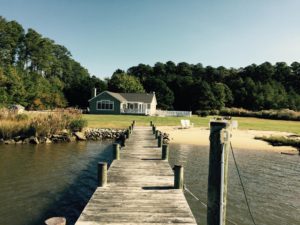
Our Cambridge Ironman HQ
There stood a modest one-story ranch home, but on a huge amount of acreage that backed up to a lake. It had it’s own dock, fire pit, pool, and a beautiful deck. Inside it was an open floor plan with a dining-kitchen area, huge great room and three good size bedrooms. It was decorated modestly, with wood floors and a kind of rural, yet updated and upscale charm to it. All of the appliances were current models in the kitchen and baths with flat screens in each room, and a large one, in the great room, a fireplace and gigantic sectional couch that all of us could have slept on.
What was even luckier was that it wasn’t only Hunter, Jamie and myself, but Kenneth and his parents, so by sharing it, the cost was not even half of what we would have to pay for the hotel.
I also have to say, that Ken’s parents, treated all of us like we were their kids. His Mom, Lucy, cooked and cleaned for us, and his Dad, Phil, grilled, shopped and chauffeured us around to make sure we were at the right place at the right time. It was like Ken, outsourced his parents to us. Of course that wasn’t the case. It seemed like they genuinely loved doing it.
It came time to travel over to transition and pick up our bikes, and then head to Ironman Village to check-in.
We reached transition and since Hunter and Ken already had their bikes, because Ken and his parents drove them up, they headed out to check out the swim start while Jamie and I talked to Tri-bike transport. Jamie’s bike was already in the rack, but unfortunately, mine was not to be found. My stomach took a little turn when Drew, from TBT, said I wasn’t on the list to have my bike at the race.
Luckily, he said that my bike was in the truck, but it was with the bikes that were sectioned off for the athletes that were not going to be returning.
I headed over to the transition area to scope it out and then took a quick peek at the swim start and at that point, my anxiety started to increase. This was happening. There no “ands”, “ifs or “buts”. I was going to be racing my third Ironman.

Ironman village was exactly as it was for every other Ironman and Ironman 70.3 I have raced except, because they were not able to keep all of the original volunteers procured, it was a lot slower checking in. We waited in line for close to two hours before we finally made it under the tent to pick up our packets and swag.
When we finally got through that line, we contemplated going into the Ironman store, but the line to check-out was just as long and we still wanted to get a quick workout in. In every Ironman store I have been in, for every race, the cashiers, (bless their hearts) are always so slow that you know if you do get in that line, it is going to be a lot of time.
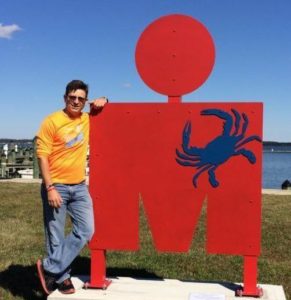
We headed back, and unfortunately, I had yet to receive a call from Drew to tell me that he was able to dig out my bike, so the others headed out on their bikes and I decided I would just work a little while I waited for his call. At 4pm, I did receive the call and 45 minutes later I was back at the house with my bike.
Leading up to the Saturday morning, was pretty much the same as any other long race. Putting gear bags together, going over transition and nutrition plans, and quick workouts in all three events. These were basically just to make sure everything was in working order.

The Goof, Ken, Hunter, Jaime & Ed before a swim workout
Did I mention Thursday night we had a campfire and made s’mores? Yeah, we did that too.
I was pretty shocked at how well I slept Friday night. We had all turned in quite early, in anticipation of not being able to sleep, but I drifted off pretty fast and slept until the 4:00am alarm woke me up. None of us were in a rush as we all felt pretty prepared, and the outside temperature was only in the upper 30s. I dressed, ate and leisurely grabbed my morning bag and we headed out into the darkness.
Leaving the house I had yet to really feel nervous, but as soon as we pulled up to transition, I felt a pressure in my chest. My heart started to beat so hard, I thought it was going to crack through my rib cage and take off on me.
I looked over at Jamie, and she looked back and said,”Sh*t just got real.”
After outfitting my bike with my nutrition and helmet, I took a walk over to the actual swim start line and looked over the water. Waves didn’t seem that bad, but the water was far from calm. I could feel the wind on my skin even through the wetsuit. Luckily, while it was 38 degrees outside, but the water it was 63. That was going to work in our favor, as it was actually going to feel warmer in the water.
Around 6:40, Jamie, Hunter, Ed and I were all hanging out trying to keep warm and maintain a positive mental attitude, when the speaker echoed our announcer’s voice. The safety team had stated that the winds were causing a lot of churning in the water, so the boats and paddle boards could not take their places on the course. The solution was to shorten the course to 1.2 miles.
I should have been really excited about this, as the swim is my weakest event, but I wasn’t. I was actually a little upset not only because I wanted to prove to myself I could get out of the water within my goal, but also for Ed and Hunter as this was their first full distance Ironman.
What else could happen? First they postpone the race, and now they shorten the course. This race just seemed cursed.
That was not the end of the story. Around 7:10, an announcement was made that, the winds had died just a little and would be enough to get most of the swim in. We would do the swim, but we would be about 800 meters short.
Things just looked better. I felt redeemed and a positive relief flowed through me for about half a second. I still had to get passed the swim. If you remember from my post about my last Ironman, I was the last one out of the water to be able to cross the line. I worked a lot harder on my swim this training cycle, now I would have to prove it.
At 7:30 we lined up according to how much time we thought it would take us to swim the full 2.4 miles. I lined up at the behind the 1:30 sign and after waiting another 20 minutes to get through the line, it was my turn to jump in.
The water still frigid enough to shock my body a little, but my adrenaline kept me warm. I immediately headed to the first buoy where we would turn right and then head in triangular pattern.
I felt really good during the first lap. For the first time in an Ironman race I was actually passing people and it felt amazing. I still felt pretty strong as I made the turn for the second lap, but I did slow down a bit.
As much as I thought I loved my long sleeve wet suit, I didn’t have the mobility in my arms, that I developed during training, and I had to strain to lift my arm into a streamline position. I listened to myself hypothesize about it and I thought, “Am I really thinking this? Did I really become a decent enough swimmer to even contemplate it?”
On the second lap, the wind picked up again and I thought I was swimming in my washing machine. I got tossed around and the effort level increased. I did end up breast stroking intermittently for a few minutes to catch my breath and realign my siting, but I continued. My habit of zig zagging didn’t show up until the last straight away while I was trying to sight on the finish. The waves were pushing me in the wrong direction, but my sighting was able to put me back on a good path. I jumped out of the water and ran towards the timing mats, and as I crossed I looked down at my watch – 1:10.
1:10? Really? I had to double check it twice. If I added the 800 meters back on I would have finished around 1:25-1:30 which, was my goal.
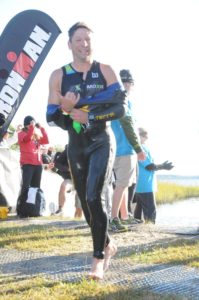
I was so excited I sprinted to the strippers, but for some reason they didn’t help. My wet suit would just not come off of me and when it did, oh man, did I feel the weather. The wind hit me, and my soaked tri kit, like a brick wall.
I headed into the changing tent and dawned a bike kit, arm warmers, a gator neck, and gloves. By the time I added my helmet I looked like a Tri Ninja.

Ed gave us a quick rundown of the bike course the night before, as he came up earlier in the year and actually trained on it. He explained how the course was an oval and we would probably have a head wind on one of the shorter sides and away or back to transition. This would account for two blocks of 12 miles since we had two laps. I was ok with it. I would just turtle for those 24 miles. (This is a technique keeping your head down and allowing your back to come up like a turtle shell to be as aerodynamic as possible.) The rest of it my plan was to stick to 75-80% of my functional threshold power(FTP) as possible. In training that proved to be right around 20 miles per hour which should get me back to transition in 5:35, and then taking account for the wind, sub 6 hours.
No such luck. I have never ever been on a bike course where the majority of the turns were to the right, and kept being hit by the shear force of a 33 mph head wind.
I wish that were the only factor that slowed me down.
I knew because of the temperature that I would not want to drink, but due to the fact my calories were mostly in my bottles, I would have to. What I didn’t count on was that I would have to stop at a portlet every 10-15 miles to urinate. I am just not die-hard enough to urinate while I am on the bike, and we were specifically told that if athletes were caught relieving ourselves outside of designated facilities they would be DQed. That slowed me down.
From mile 40 to 50 we were all riding on the shoulder of the road, into the wind. Directly to the right of the white line were slowing rickets with very small spaces in between them. They seemed a little dangerous, so everyone was either on the right of them, or on the left and swerving to the right when traffic would come from behind.
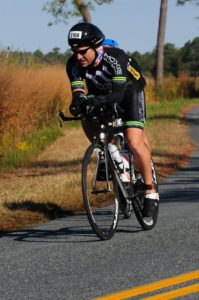
I was in aero, with my head down, when I saw a tire in front of me, so I yelled “On your left.” The wind was so loud the person in front of me, wearing a “This Guy Needs A Beer” jersey, could not hear me. As I slowed down to keep enough bike lengths between us to satisfy the drafting rule, I noticed a motorcycle next to me. It was an official.
He pulls out a memo pad and yells to me, “At the next penalty box, tell them you have blue card.” Well, I wasn’t going to start arguing while I was the bike, so I nodded.
At the mile 56 aid station there was a penalty box, so like a good athlete I did what I was told, and so did the other seven athletes that came in behind me. There we all were. Eight, age group, athletes standing stretching while we waited for our five minutes to be up. I am all for rules, order and safety , but it’s a little ridiculous when there are eight people in the penalty box all caught doing the same thing on the same stretch of road. As this was my 3.4 hour mark on the bike, I asked the volunteer who had to time the penalties how many he had so far. He kind of smirked and said it had to be over one hundred.
At that point I just had to laugh. I got back on my bike and continued trudging through the wind.
Ten miles later, a slow burn started aching my legs. I didn’t understand it. My cadence was up, but no matter how high I shifted, I felt like my effort level was increasing. Then I heard what was a metal grinding. Yep, you guessed it. A flat in my rear tire. These were brand new tubular tires, I had installed just for the race, and now I punctured them. I had a bottle of pit stop in my jersey, so it was only a couple of minutes before I was back on my bike. With Pit Stop, I didn’t even have to take the tire off, just empty the contents of the bottle into the tire and go.
Luckily, I didn’t have to stop nearly as much the second loop as I did the first to urinate, so I picked up a little bit of time, but while keeping to my FTP goals, I could barely get above 17 mph. It felt slow and torturous.
The left turn for the last 12 miles came and I thought maybe we would catch a break and as I passed the last aid station one of the volunteers yelled, “Your on your way back, no more wind!”
He lied.
The whole way back to transition, the wind hit us and kept our pace to a slow 16-17 mph.

As I dismounted my bike, I could feel not feel my toes or my hands, and I was just frigid. I tried to take off my bike gear, and it was extremely difficult. I felt like I did, during the last ironman at mile 13 of the run and I hadn’t even started the run yet.
The grumbles in the changing tent were all the same. The bike was windy, it was tough and it sucked, but it was over. A few of the guys who competed in last year’s event said they were over an hour slower than the previous year. That actually made me feel a little better.
I have a saying I give to my athletes when they start to walk or I find them giving up on themselves. “The mind will quit 100 times before the body does.”
For a nanosecond a thought went through my head. “I already did two of these, I don’t need to prove anything to anybody. Forget this.” Then the next nanosecond went by with my inner dialogue that said “Who are you kidding Minus? You know you are going to finish if you have to crawl across that finish line. You never quit anything in your life, what makes you think your going to do it now?” The last words that echoed in my voice were that of my coach Jon Noland. “Embrace the Suck.”
I changed the best I could with numb fingers and toes and started the run. (I found out later I spent over 20 minutes in T2. It sure didn’t feel that long. I must have taken a nap.)
The first two miles felt a little slow, then at mile three it was like the pearly gates opened up. My legs transitioned into a good running form and I took off. I felt amazing.
I kept to my strategy of walking through the water stops, which during an Ironman is every mile, but they are only a few yards long, unlike those at a major marathon, where the distance could exceed a hundred yards.
At mile seven I actually felt a side stitch which hasn’t happened in a race in years. Luckily, I still had my wits about me. What is the cause, or better yet, what is absent from my body that would possibly cause a stitch? Potassium. Wouldn’t you know it but an aid station was just fifty meters ahead of me, so I grabbed a banana. Within the next quarter mile, the stitch was gone, so I picked up speed again.
The course was two-and-a-half loops that took us from transition through a residential neighborhood, around a park, back through the neighborhood passed transition, into downtown Cambridge where it either started again, or headed to Ironman Village and Finish line.
We had been told that Cambridge was supportive of the race and even in these cold temperatures, the town was out in droves.
Along the route there were kids on their lawns cheering, a dancing banana, residents on lawn chairs, and local bands playing outside their homes. While running through downtown people were outside the bars drinking and cheering every athlete on as they passed. It was just spectacular.
I found Jamie ahead of me around mile 5 and we ended up passing each other three more times. Each time I was getting closer and closer to her. I had hoped to get closer, but in the end she did end up crossing about three minutes ahead of me.
I never ran over 90% of the run during an Ironman before. This time the only time I walked was through water stops and only stopped twice to use the portlet. Granted it was not extremely fast, but it was still over twenty minutes faster than my best Ironman.
My legs at mile twenty were very heavy and this was the half lap and the last time I would have to turn left after downtown Cambridge. I kept going, and didn’t stop but it was getting quite dark to a point where there was a portion of road where I couldn’t see my hand in front of my face. I just kept going.
The thing I just kept thinking in my head was one day, I would finish an Ironman and it would still be daylight.
I came out of downtown Cambridge and made the right towards the chute. I heard the announcer call my name and as I saw the arch of the finish, I wondered if I had it in me.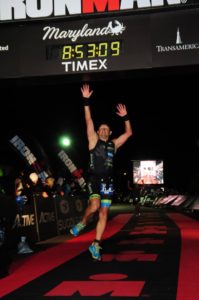
I ran just a little faster and jumped up, caught a little air and touched the arch. I was an Ironman. Again.
My finishing time was 13:08:53 which was actually and hour and forty-six minutes faster than my best Ironman, but if I kept the same pace on the swim, I calculated I would probably have crossed about 20 minutes later which would have given me a ninety minute personal record. In those conditions, I‘ll take it.
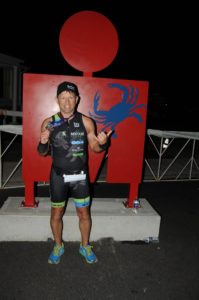
Of course I did not do this alone. I have to thank my coach, Jon Noland for training me (coaches need coaches too), the athletes at Tribal Multisport for pushing me further than I thought possible, the Moxie Multisport team for the help with gear, nutrition, and the support to keep me going through the long training period, my travel and housemates, Jamie, Hunter, and Ken for the great time at the house, and for keeping me sane and laughing, Ken’s parents, Phil & Lucy for the race weekend support, and last but never least, Kim for supporting me at home through this third Ironman.
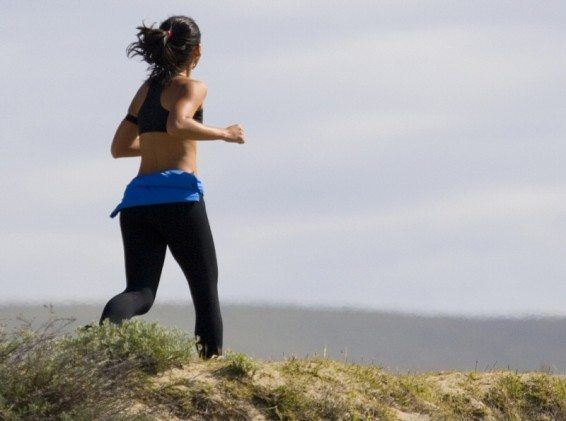
I can hear it now….”Know wonder they call you a Goof…you are crazy.”, “So, if I run slower I will get faster? You are out of your mind.” It was not to long ago I used to think the same thing, but as with everything I post, there are reasons and science to back it up.
Let’s face it, logic would dictate that pushing the pace of your easy days, as close to race pace as possible, would help you get fit faster and help you speed up, right? A lot of coaches, including myself, will tell you to run slow on your easy days, and easy days should be making up anywhere from 50-75% of your weekly mileage.
I have clients continuously asking me, “why are my easy days so slow?” The latest is my famous sit downs with my runners telling them to slow down after examining their data and finding them running tempo speeds during an easy day.
The answer to the question is what Arthur Lydiard and most other coaches would call the aerobic system. The aerobic system, or aerobic development, is the one of the most important fundamentals into unlocking your true potential.
Let us first check the stats on the energy contribution the aerobic system provides for races. As you can in the chart below, even the shorter events like the mile, over 80% of the energy required to run the race is produced via the aerobic system.
Aerobic training is the scientific fact that to move your body at higher intensities, the body needs to break down sugar and convert it to glycogen so it can be used as energy.
The aerobic system plus oxygen starts a chemical reaction known as Aerobic Glycolysis which continuously powers continuous endurance activities. In the aerobic system energy ATP is produced through Pyruvic Acid and Lipid/Protein fragments entering the Kreb Cycle and the Electron Transport Cycle.
Uh…what?
During aerobic respiration (yeah, that’s breathing) the body uses all the oxygen it needs to power the muscles. When you are running in your “aerobic zones” (easy runs), your muscles have enough oxygen to produce all the energy they need to perform.
See? Improving your capacity to transport and efficiently use all the available oxygen to produce energy will enable you to race faster since this makes up 85-99% of the energy needed to race.
Since running easy is aerobic development, what better way is there to train the aerobic system? There is none.
Capillary development – capillaries are the smallest of the body’s blood vessels and they help deliver oxygen and nutrients to the muscle tissues while exporting waste products out. The larger the number of capillaries you have surrounding each muscle fiber, the faster you can transport oxygen and carbohydrates to your muscles.
Aerobic training (easy running) increases the number of capillaries per muscle fiber, thus improving how efficiently you can deliver oxygen and fuel to your working muscles and how quickly they can clear waste products.
Myoglobin is a protein in the muscles that binds the oxygen that enters the muscle fiber. When oxygen becomes limited during intense exercise, myoglobin releases oxygen to the mitochondria to produce more energy.
The more myoglobin you have in the fibers of your muscles, the more oxygen is transported under aerobic stress. Like, uh, during a race. Aerobic training increases the amount of myoglobin you have in your muscle fibers.
Mitochondria are microscopic organelle found in your muscles cells that contribute to the production of ATP (energy). In the presence of oxygen, mitochondria breakdown carbohydrate, fat, and protein into usable energy.
Therefore, the more mitochondria you have, and the greater their density, the more energy you can generate during exercise, which will enable you to run faster and longer.
Aerobic training increases both the number and the size of the mitochondria in your muscle fibers.
Suffice it to say that aerobic development is the single most important factor to long-term development.
Of course, track workouts, VO2 max sessions, tempo runs and cross training will increase your fitness and are still incredibly important to racing faster. However, nothing will help improve continuously like developing the aerobic system.
Aerobic development is dependent upon running in your aerobic zones (for my runners Zones 1-3). This is why running faster on your easy days develop the aerobic system. Once you step out of those aerobic zones, on easy runs you diminish development of your aerobic system, but you also increase the chance for injury. Nope, two negatives do not make a positive in running.
This is one of the single biggest mistakes runners of all experiences make in their training.
As a coach and trainer I have always distinguished myself because I am always able to give my clients and readers the “why”. (Sometimes my clients end up telling me to just shut my mouth. when I am training with them because I am continuously telling them why they are doing each movement of an exercise or workout. I guess it may not be an advantage all the time. Go figure.)
Scientific research has been able to identify how the aerobic system adapts and responds to certain training paces. Physiologically we know:
It is pretty clear now right? Your optimal easy run pace for aerobic development is between 55 and 75 percent of your 5k pace, with the average pace being about 65 percent.
It’s also evident that running faster than 75% of your 5k pace on your long run has very little additional physiological benefit.
In fact, the research indicates that it would be just as advantageous to run slower as it would be to run faster. Running around half of your 5k pace is pretty easy right? Wouldn’t you know it, the evidence is clear that it still provides near optimal aerobic development.
Feel free to let me hear your feedback. I welcome any other case studies, personal experiences and other research as I am always learning. I provide you with the best content I can, but I have an open-mind and know that there may be other research out there that may negate information I post.
~IronGoof

HITS is a fairly new triathlon series, with a unique concept. Their tag line is “A distance for everyone”, which really says it all. A HITS weekend consists of 70.3 (half-iron distance) and a 140.6(full-iron distance) on Saturday, and on Sunday, Sprint and Olympic distance triathlons. It is a pretty cool concept, and they are really well-organized.
After having breakfast with the Team Foley after the Fight for Air Climb I headed out to Ocala with the hope of seeing at least Margie, Kari and Megan cross the finish line. I have to admit, while I have been training, it hasn’t been as focused as it should have. My “off-season” mentality didn’t quite transition into the race attitude just yet, but I thought I was at least in shape to do the Oly. In triathlon season, usually the first couple of months, is usually “Base” phase which just gets the wheels and legs rolling again, develop some strength and start gaining the endurance needed for race season. With that in mind, I figured an Olympic distance would be perfect to baseline where I am in my training. Imagine my surprise when I saw a lot of my friends out on Saturday competing in the 70.3. As I was watching competitors and friends cross the line there was a familiar itch developing in my heart. I didn’t quite notice what it was at the time.
The course for the 70.3 was pretty intense with loops that included a 1.2 mile swim in a 65 degree Lake Weir, 56 miles of rolling hills and wind of the bike, and an intense mixture of soft trails, and asphalt out-and-backs for the 13.1 mile run. I was too busy losing my lungs to catch any of the swim or bike, but I was happy to be around to see the finale of the run.
I had my first blog recognition, which was really nice. I was at the expo, grabbing a couple of Honey Stinger gels for my race the next day and I was chatting with the owner of Kickstart Endurance and she told me she followed IronGoof. I tried not to make a big deal out of it, but secretly I was really excited.
I missed Margie, but I was really happy to see Megan and Kari cross the finish. They both were finishing their first 70.3 along with some other members of the Tri Psych Club, so for them this was a huge accomplishment and deserved a celebration. That itch started to intensify at Chili’s that night as everyone’s conversation about their race surrounded me.
I really attempted to be nonchalant about this race. I kept telling myself, “Self, this is no big deal. You know you are not ready to race, this is a small race and this is going to tell you what you need to work on.” Unfortunately, waking up the next morning at 4:30a, and preparing my gear not only woke up my consciousness but the competition juices and anxiety levels as well. I showered, dressed, applied my TriTats, loaded the car and off I went.
As I mentioned before, the organization of this race was first-rate, from, staff organizing parking to the transition areas. Have I mentioned the transition area? In previous races I have barely glanced over the amenities of the transition areas, well except for the Rev3 Venice Beach. Let me put it this way, if the transition areas were cars, then every other race I have been in were Toyotas, the Rev3 was a Lexus, and the HITS series was a Bentley. Not only were there boxes that held gear and clamped a tire for easy removal of the bike, plenty of room for transition setup in-between the bikes, but each participant had their own personal stool with their number and last name on them. It doesn’t sound like a lot, but it really is the little things that make an impression.
I headed down to the beach with my wet suit on halfway, goggles and swim cap in hand. The temperature outside was perfect with just a slight breeze and the sun was starting to slowly creep up over the horizon. I was incredibly grateful to see my friends down on the beach. Pete, Kari, Megan, Michael, Stan and a couple f others as it made me feel slightly less stressed. After the mandatory meeting, all of the males waded out a bit into the water for the start. My anxiety reared a little due to the fact, I was using my backup goggles because my regular goggles broke in transition and this was the coldest water I had ever swam in.
The whole beach counted off, “Three, Two, One…” and the horn blew. We all ran or dolphin dived toward the first buoy. The water was kind of shallow so I did have some time to start to get used to the water. I remembered my strategy and my stroke count and I started swimming. I started losing ground within the first 200m, which was normal for me. My new stroke technique is still relatively new, so I figured I wasn’t going to be fast immediately. When I reached the first buoy, I started feeling short of breath, even though I thought I was relatively relaxed. My chest started to feel compressed like I was being stepped on, and my arms were not moving as freely as I wanted them to. I moved to breast stoke to see if I could relax a bit, but it was to know avail, the compression would just not loosen. I have never had an issue with my wet suit. Except for getting out of it, I kinda like it. I feel more buoyant, warmer and protected from other things that may cause issues in open water. Now I just felt like it was python, strangling me. I kept going, but it was a combination of freestyle, side stroke, and breast stoke. When I reached the second buoy, my mind went into overdrive trying to get me to quit. The ideas popping in my head were asinine. I kept hearing, “You aren’t trained for this”, “You don’t belong here.”, “Just get out of the water. It is only a baseline remember?”. The thing was, I had another loop to do. I swam toward third buoy, and the water became very shallow, so we really didn’t have any choice but to run through it and start dolphin diving again. I forced myself to have the one thought that has gotten me through tough training, cold, wet and rainy workouts, and exhausting races; “The mind will quit one-hundred times before the body does.” I told myself, “Self, that is first and only time that is going to happen today.” I ran around the third buoy and headed out for my second loop.
The second loop felt a little better, but I was so happy to get out of that wet suit. I am still not quite certain why I felt that way. It wasn’t the size of the wet suit because when I bought it I was 25 pounds heavier. Either way I ran out of the water unzipping and getting out of it on my way to transition. One of the strippers told me to lay down and she yanked it off of me. I grabbed my helmet while I put on my shoes and crossed the mat in less than 3 minutes.
The bike course was actually pretty nice. Rolling hills, with well conditioned roads and plenty help by the Sheriff’s department. I wanted to make up sometime, so in my head I thought to just keep passing people. I only got passed twice during the first ten miles of the twenty-five mile course and I was happy with that. I played cat & mouse with a couple of them, and ended up passing them in during the last half of the course. Unfortunately, there was a storm on the horizon and the wind picked up quite a bit on on the second half, not to mention the hills were more abundant and steeper(at least for Florida). My speed, that I was holding quite consistent at 21 mph started to drop to 18, then 17 and at that point, I refused to go under 18 mph. I came into transition, averaging 19.1 and I was proud of that.
I racked my bike and sat on my stool to put on my socks and shoes. I got hung up a little bit, but was still out of there in less than 3 minutes, and it was off to the run. Pete yelled at me as I headed into the trees, “This is the fun part”. At first I agreed with him.
I decided to wear my Hoka One One Biondi Speed 2 running shoes with the large sole, because I wanted to test how they felt on a triathlon after being on the bike. Big mistake. At first the ground wasn’t very soft, and I was ok running about an 8:15 mile, but as I got further into the woods, the trail got softer and softer. With that big sole, not only was my foot pushing down on the sole, but then into the soft ground causing three times as much resistance as the a regular running shoe. I didn’t figure this out at first, but after one-and-a-half miles, I felt like I needed to stop, and that was not usual, not matter what kind of shape I was in. I walked at the aid station for about 200 yards and then I continued running but at a much slower pace. I had to do two loops of the run course as well, and I could feel the resistance ease off when I hit the asphalt again. All of the sudden I was lighter and faster, but I had to do a second loop into the woods again. I decided my strategy would be to walk a hundred yards at the aid station and 100 yards at the turn-around, but other than that I would let my legs do what could. It worked out well as my splits were faster on the second loop.
I ran out of the woods with Pete snapping shots and hearing cheers from Megan, Kari and a couple of others. As, I  crossed the finish line it became clear to me, that I am not in the shape I was in for my last 70.3, but I would enjoy this moment as a victory. It was not a PR, but it this race let me know what I need to do over the next months in order to take on the rest of my race schedule.
crossed the finish line it became clear to me, that I am not in the shape I was in for my last 70.3, but I would enjoy this moment as a victory. It was not a PR, but it this race let me know what I need to do over the next months in order to take on the rest of my race schedule.
After calming down a bit and chatting with Pete and a few other friends, Summer Bailey found me. She had competed in the 70.3 the day before. Summer lives in Georgia, so we really only see each other at races and occasionally chat on Facebook so it was really incredible to actually chat and catch up with her in person. She is an amazing woman and with a huge heart and ferocious determination. We both agreed that neither one of us had trained enough for our races, but it was good to have a race under our belt for the year. Chatting with her was encouraging, and I know we will be seeing each other again during the season. To be able to see and chat with her and some others that I do not get to train with allowed me to remember one of the greatest thing about triathlon and racing in general. It’s the friends and connections we make. Other than having a good race and crossing the finish line, it is the best part about it.
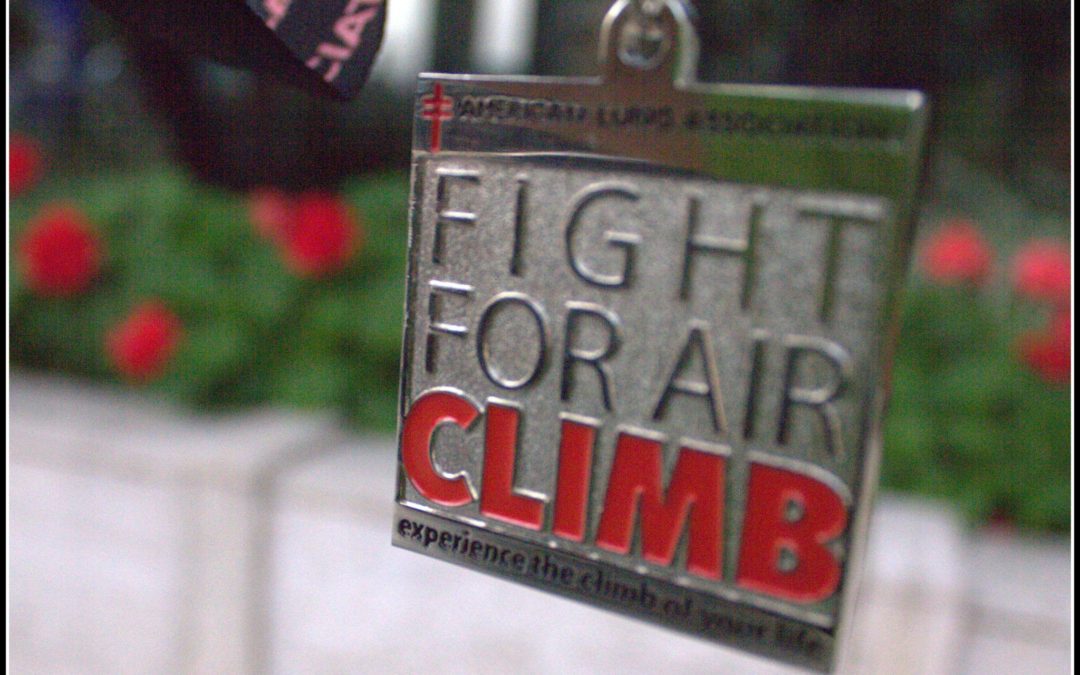
What a weekend! I raced with Team Foley Saturday during the Fight For Air Stair Climb in Tampa at the Bank of America building, then I did my first triathlon of the season at the HITS Ocala Olympic Triathlon. Needless to say come Monday morning I was a little stiff, but full of rigor because of what I accomplished.
Saturday morning the alarm went off at 5:30am which actually was about 45 minutes later than during the week. (WOO HOO! I got to sleep in.) I had no trouble jumping up, taking a quick shower to wake up, and heading into downtown Tampa for the Fight for Air Stair Climb. These stair climbs are sponsored by the American Lung Association and are held all over the country. The Tampa event consists of a team event, an individual event and a firefighter event. The Team Event, incorporates an undetermined amount of members on the team, and is scored with the top 3, lowest times. The members of teams, and athletes not members of teams, are entered into the individual event which incorporates the common age groups and is scored based on the individual’s performance. The firefighter event, is strictly for active firefighters sporting their full protective gear. Boots, pants, coat, helmet, tank and mask, while then racing up the 42 flights. It is an incredible site.
I have been a member of Team Foley under the leadership of Captain Lisa Jamison for the last couple of years.
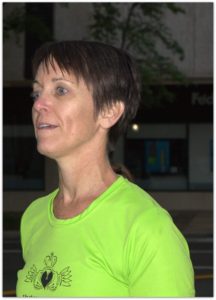
Fearless Leader
Lisa Jamison
John Foley was a good friend of hers whom passed due to lung cancer, so our team has always dedicated our performance to him. The last two years we finished first and won the team competition, but unfortunately a team named “7 Minutes of Pain” ended up winning, but we finished a close second.
The event starts with the normal registration and announcements outside the building and then the teams are brought in by their predetermined time, to the stairwell. The bibs we are given have timing chips built in and a couple of steps before the first set of stairs is a start mat with the finish mat at the top to capture the times. We arranged ourselves from fast to slow, so their would be very little passing that would cause a delay in any team member’s time or interrupted strategy. I was positioned right behind Eric Scola, a CrossFit instructor and friend who was in obvious excellent shape. He took off as I waited required 10 second gap in-between athletes before I started my journey to the top.
For such a short race, it feels like forever. There are different strategies to running the stairs. Last year I blasted up 15 flights, before my lungs decided they had enough and I had to slow down. This year I decided to take the same pace all the way up. I found a rhythm of pulling on the rails and double stepping almost the entire way. I did take a few single steps about 4 times during the duration of the race, but I mainly stuck with the double. It ended up working for me with a time of 7:22 which was just about the same as I did last year, but I felt better and recovered faster. In 2012, my lungs started really burning around floor 30 and it was very difficult to continue and it lasted almost 30 minutes after I completed the climb, but this year I ended up at the top feeling pretty good. That is, until I sat down. The burning sensation caught up with me as I was recovering in a small room at the top with a bottle of water. It was very uncomfortable. Thankfully they did not allow us to stay as long as we did in the past and shooed us back downstairs. With the fresh air, I ended up recovering in about 5 minutes from the moment I exited the building.
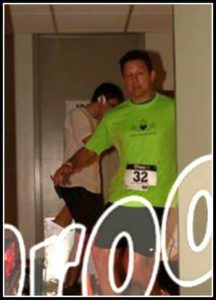
Finish
There is no ventilation in the stairwells or humidity for that matter and I believe after using maximum effort without regards to heart rate or respiration rate, it leads to that burning sensation for me.
After recovering an drinking some more water I found myself feeling really good. It is the longest 7 minutes of my year, and I am so happy I have the ability to fund raise and compete in this race for Lisa and Team Foley.

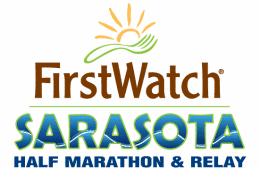
I am a little behind on posts, and now need to add three more due to being sent and then utilizing three new products during the race; the Hoka One One Biondi S2 running shoes, the Jaybird Sport Strap bluetooth headset, and Wrightsock Stride running socks. I will do my best to get those reviews completed as soon as possible, but for now let me tell you about my experience with the US Road Races Sarasota Half Marathon.
I learned a lesson first thing because I ended up running a tad bit late in the morning. The drive time to Sarasota usually is 45 minutes and I thought I was going to be fine until two miles from the race start. The traffic came to a dead stop. I drive a Mini Cooper Clubman, so while maneuverability is not an issue going over things like medians become either not possible, or the consequences may turn out to be expensive. I was stuck behind a tractor-trailer semi trick with my right lane blocked and a huge median to my left. No way out. After a while, of being a little stressed of missing the start, I noticed the median curb height had changed to regular curb height so I took the chance and allowed my little car to climb over it. Luckily I found an alternate route, and parking pretty fast, but a ways from the start, so involuntarily I sprinted a quick warm-up mile prior to the gun.
I could hear the National Anthem being sung as I was running to the start, which told me it was going to be tight making it, and of course there were close to 5000 runners, so I ended up starting in the 13 minute/mile corral. At first I was a little disappointed, but it gave me a little time to stretch and calm myself down. I usually start up near the front of the pack, and end up getting passed throughout the race, however this time it was me who was doing the passing.
Miles one and two ran along Tamiami Trail and over a bridge which wasn’t very steep, although it felt long, but it did allow for some recovery on the other side. Some coaches worry about their runners as they run downhill, but the form I teach really allows the ease of just letting the legs do what they will allowing for a nice recovery. Of course I also coach a way on the uphill that makes the effort feel a lot less as well, but that is for another time.
The 5k split ended up in a circle downtown and according to my split time, it wasn’t bad. 23:24, less than an 8 minute mile for the first three miles, I’ll take that. Miles four and five were back over the bridge and past the start/finish line. Unfortunately, my sock started slipping in the circle, so after mile 5 I actually had to stop, and take off my shoes so I could re-position my sock. I couldn’t believe it. Because I was product testing my shoes I did not put lock laces on, so I even had to untie and re-tie the laces. I think it was 3 minutes wasted. It wasn’t a huge amount of time, but it still irked me. I will talk more in my review of the socks.
After that it was just a lot of fun. I caught up with some friends along the way, Holly Tripp, Teresa Gadient, a couple of others and chatted and then continued on my way. It was a beautiful course that ran inside a nice residential area and then back to the finish. The view was not anything spectacular, but a decently scenic throughout the course. The weather held to mid 60’s throughout the morning, which is perfect for me.
The last couple of miles were back down Tamiami Trail and then turned back into the community center and into the finish shoot. I picked up the pace on the last couple of miles and actually had enough for a little sprint kick at the end, which I haven’t had in a while. I wish I could figure out what I did, that made that difference. It could have been the steel-cut oats I had that morning, or even a new natural supplement I started a month ago, but I definitely had a little more than I thought. This would have been a nice PR race, but my strategy was negative splits, and very conservative. Next half I’ll do it.
There is one thing to be said about starting in the back and passing people up versus getting passed. Positive/Negative reinforcement. It shouldn’t feel that way, but I believe I also had some energy build from passing everyone except for three whom passed me. Positive conditioning. Starting in the front and getting passed no matter what I tell myself, still has a negative effect on my semi-fragile ego. Do not get me wrong, I know my place. I have always preached strength before speed. I have stated over and over again I am not fast…yet, but I am a strong runner and at a comfortable pace I can run forever. Unfortunately, that pace is pretty slow right now.
I met up with Ben Mena, Nick Zivolich and some other athletes and, Beth(B.o.B) joined us a bit later after finishing herself. I will say the medal is huge and beautiful and athletes running in the other US Road Race Half Marathon series, receive an extra medal with the number of races they ran in the series. If the athlete competed in 2 of the series they received a 2 inch number 2, for 3 races a 3 inch and so on. I like the concept and those medals were gorgeous too. It may be something to ponder trying to complete next year.
That was the glorious morning of my St. Patrick’s Day. I cannot think of a better way I would’ve spent it.